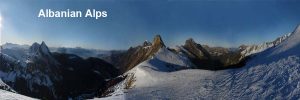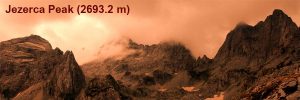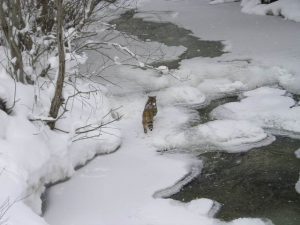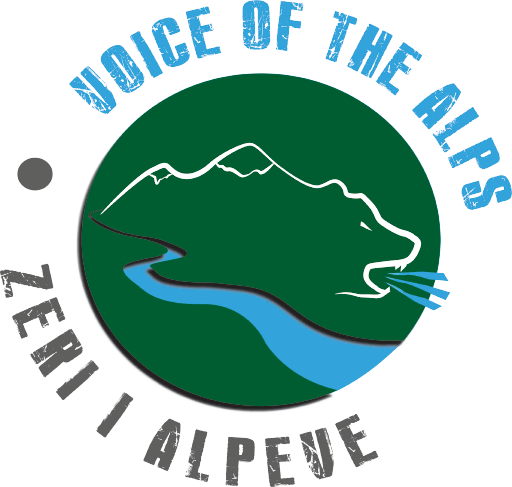 Alps represent a mountainous area in northern Albania. They represent the physical and geographical province, the highest and most sublime, their boundaries are clear. They lie in the North of Drin River, in the West of the downstream river Valbona (branch of Drin). Their total area reaches 2,020km2, occupying about 8% of land area. It is distinguished for its physical and geographical landscape diversity. In general the Alps, with their too rugged high terrain, are not insurmountable. Dense network of valleys and gorges facilitates passage through their necks, even in the deepest sectors. They have more isolated geographical positions, because the roads that connect to other regions of the country and abroad Albanian lands are scarce and not in good conditions.
Alps represent a mountainous area in northern Albania. They represent the physical and geographical province, the highest and most sublime, their boundaries are clear. They lie in the North of Drin River, in the West of the downstream river Valbona (branch of Drin). Their total area reaches 2,020km2, occupying about 8% of land area. It is distinguished for its physical and geographical landscape diversity. In general the Alps, with their too rugged high terrain, are not insurmountable. Dense network of valleys and gorges facilitates passage through their necks, even in the deepest sectors. They have more isolated geographical positions, because the roads that connect to other regions of the country and abroad Albanian lands are scarce and not in good conditions.
Simultaneously, there are distinguished the most powerful, highest, toughest and fragmented mountainous piles of the country. Their average height above sea level reaches 1500 m. Here are most of the peaks of Albania with a height over 2000m, the highest peak in the Alps, Jezerca (2694m), the second after the top of Korabi (2751m). The morphology is characterized by steep slopes, with deep valleys, narrow gorges with numerous thresholds and multiple forms of ice, where there are found lakes, forests and pastures, presenting rare natural beauty not only in Albania, but also in the Balkans.

Alps consist mainly of limestone, but there are found also terrigen-magmatic deposits. Associated with this geological construction, characteristic mineral resources of the area are: copper ore, bauxite, quartz. Also, Alps are distinguished for the blocks, highlands, mountain loins and special valleys.
The climate is mountainous (Alpine), with crisp summers, cold winters with numerous frost. Due to the mountainous terrain, there are more rainfall than anywhere else in Albania, especially in the form of snow.
Alpine hydrography is very rich. Many rivers and streams that have a fast flow, abundant water, especially in spring, when snow melts. Their water is clean and cold. There are various glacial lakes, which have beauty and great touristic value.
Land is scarce and barren, in the valley of the poor mountain slopes covered by erosion.
The territory of the Alps is known for biological and landscape diversity, thanks to its geographical position, geological and pedological conditions, hydrological characteristics of relief and climate. The steep relief, strong verticality offer conditions for the existence and preservation of a large number of plant and animal species.
Vegetation (vegetation cover) understood as a complicated and complex mosaic of plant communities, which in space are changed more or less steadily, in line with changes in environmental conditions (climate, landscape, geological and pedological composition, hydrological conditions) . Thus, the vegetation of the Alps has changed during the process of its historical development. All plant species that survived the glacial period together with new types created after diluvium, today represent different plant communities (phytocenosis), where some of them are characteristic of the Alps region. However, note that flora vegetation is at permanent risk of destruction and extinction as a result of interventions, actions of uncontrolled human activity, which can lead to the appearance of desert erosion on a large scale, not to mention the factor of climate change.

Alps, in general, in terms of fauna, they belong to Hollarctic region, Euro-Siberian sub-region. It is characterized by a very rich heterogeneous, endemic and interesting fauna. This fauna is rich because of the impact of the numerous impacts of the Mediterranean region, Nordic-alpine and euro-siberian frequent changes of ecological conditions in the past.
On the territory of the Alps are found species of insects, butterflies, fish, reptiles, amphibians, mammals, birds etc., which are quite rare for the Balkan region and beyond. Some of them are relict, endemic, rare and threatened species with unfavorable conservation status in the Balkans and Europe, therefore they are listed on the international red books.
Even geo-heritage is varied and rich. Multiple values of bio-natural, historical and cultural heritage, present a region that should be protected and used for social, economic, touristic, educational and scientific purposes according to the international standards and conditions, as complementary elements of the future national park.
